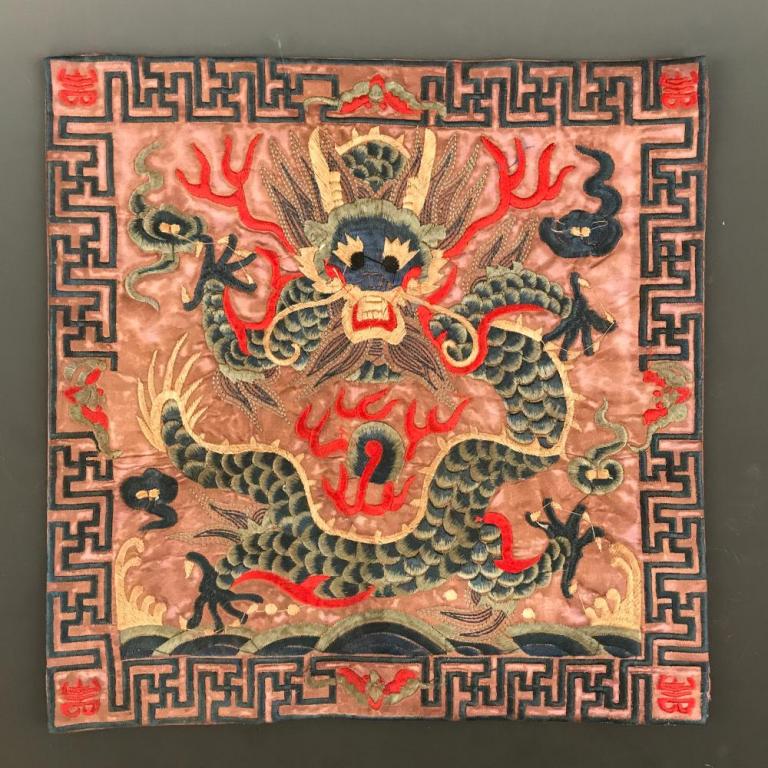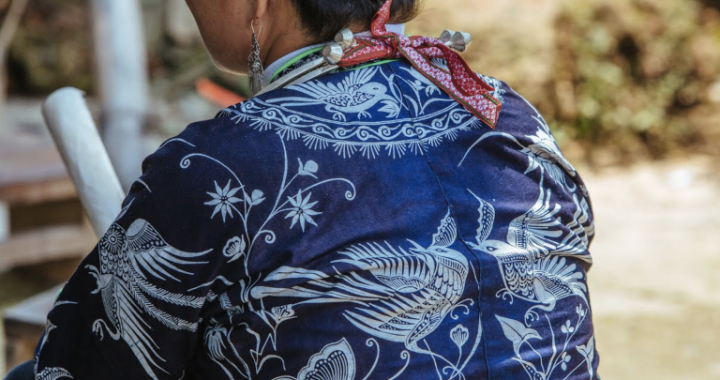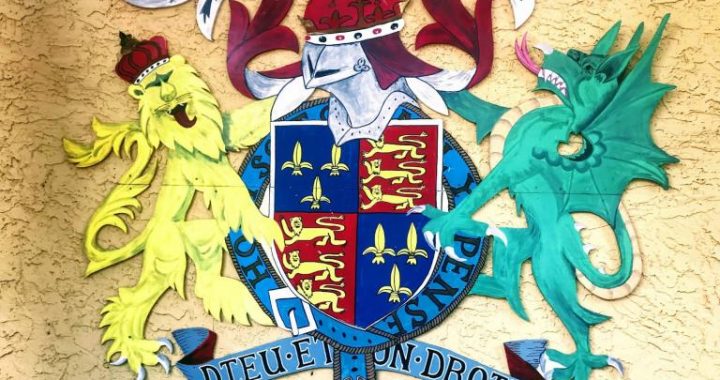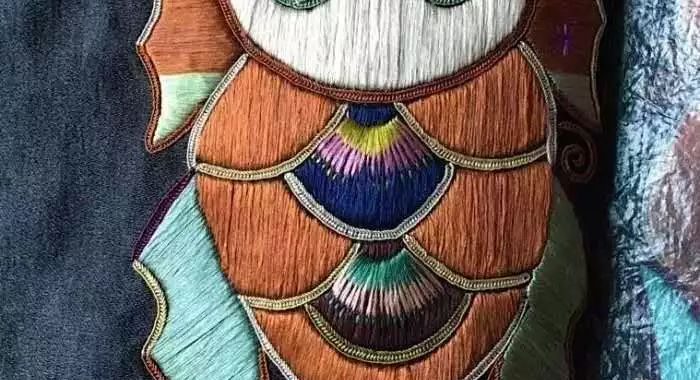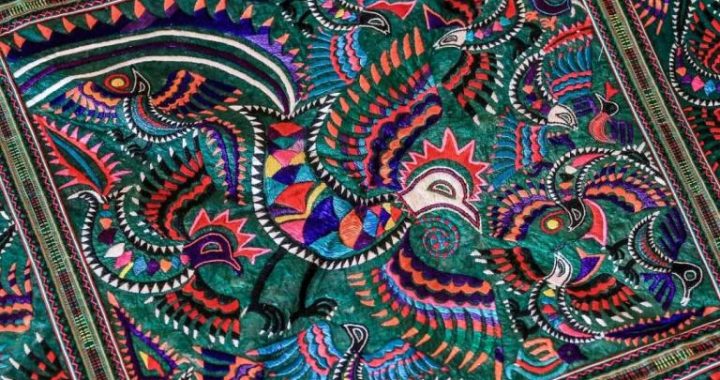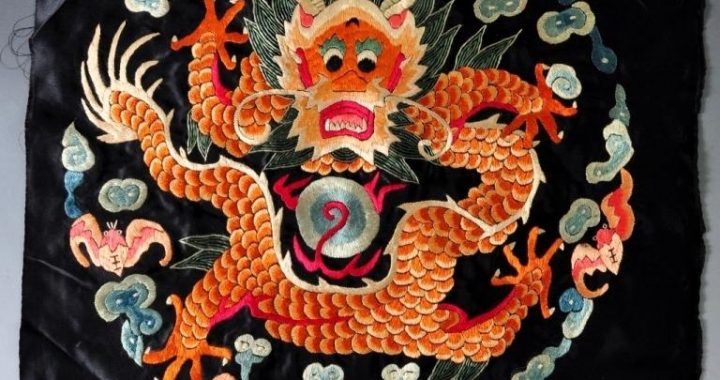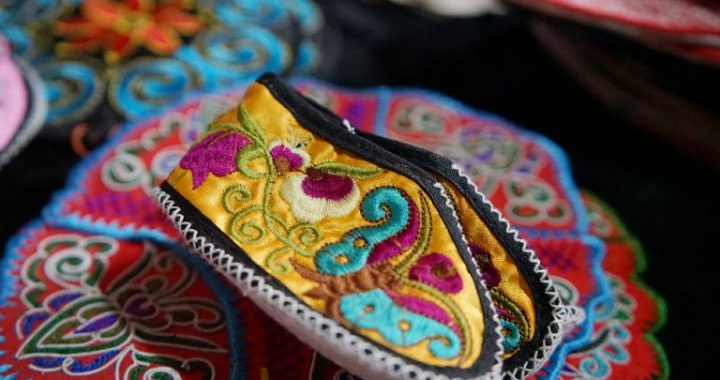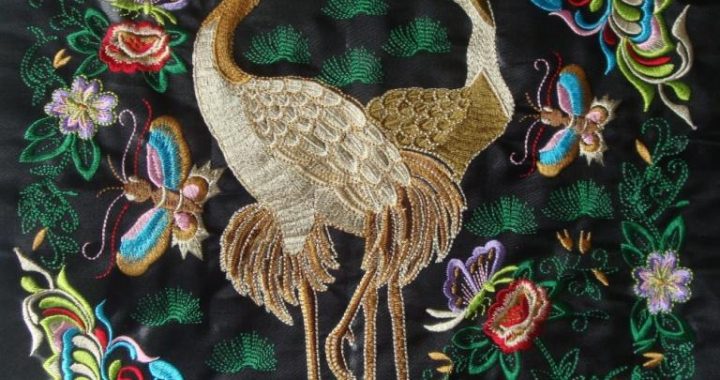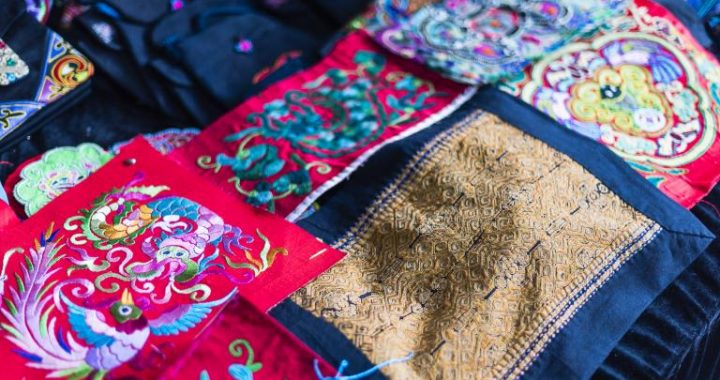Chinese Embroidery
13 min readEmbroidery has a long history in China. As early as in the Zhou Dynasty, the varieties of decorative patterns embroidered on the robes and costumes of emperors and senior officials were up to 12, including sun, moon, stars, mountains, dragons, pheasants, tigers&long -tailed- monkeys, algae,fire,rice- shaped grains, and white -black square patches, collectively known as “Twelve Ornaments.”Official costumes embroidered with patterns of 12 ornaments were called “gunfu (ceremonial robes worn by emperors and high-ranking officials).”Embroidery was once a symbol of feudal etiquette and social ranks in ancient times. Light yellow quilt with a pattern of pairs of phoenixes and dragons of the mid Warring States Period (a part) During the periods of Spring& Autumn and the Warring States, as agriculture evolved, the mode of life characterized by men farming while women tending domestic tasks became more stable, and such activities as mulberry&hemp cultivation, spinning and weaving grew more pervasive. These gave rise to increasingly mature embroidery techniques. Currently, the extant earliest are two pieces of embroidery works unearthed from Chu State tombs of the Warring States Period in Changsha, Hunan Province.
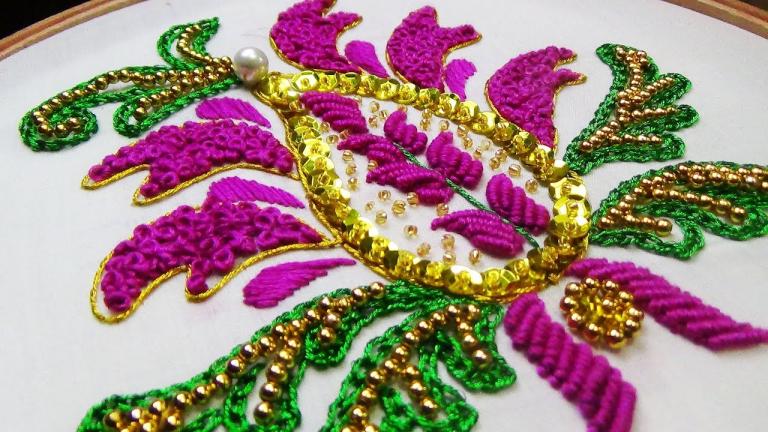
These two pieces are silk and linen embroidered using plait-braid stitches (i.e. lock-stitch embroidery), with neat stitches, elegant color matches and smooth lines, bringing the motifs of flying dragons and phoenixes, tigers and auspicious animals to life and fully reflecting the achievements of embroidery techniques of Shu State. Entering into Qin and Hang Dynasties advancements in silk spinning facilitated the developments in embroidery techniques and varieties. The techniques and artistic styles of Han embroidery are reflected by large quantities of diverse and well -preserved embroidery works unearthed from Western Han Tombs at Mawangdui, Changsha, Hunan Province in 1972. Seen from these embroidery works unearthed, Han embroidery mostly featured such motifs and wave-shaped clouds, soaring birds, galloping mythical animals and common band-shaped and geometrical patterns; their techniques were dominated by lock-stitch embroidery, with patterns filled to the full, compact composition, neat stitches and fluid lines. Among famous Han embroideries are Xinqi Embroidery (featuring migratory birds), Chang Shou Embroidery (featuring patterns of clouds and floral branches meaning longevity) and Chengyun Embroidery (featuring flowing cloud-shaped patterns). Embroidered bag with patterns of flowers and birds on thin silk of the Tang Dynasty (unfolded), 91.7cm in length, kept in the British Museum, the UK. Mainly made by plain embroidery, it is of an elegant style with vivid images and rich colors. During the late Han and Six Dynasties, Buddha image embroidery emerged, reflecting the exchanges and integration of foreign and local cultures represented by Buddhism. Seen from embroidery fragments during the period of Eastern Jin Dynasty to Northern Dynasty unearthed in such locations as Dunhuang, Gansu Province, and Hetian, Bachu, and Turpan in Xinjiang Uygur Autonomous Region, embroidery works during this period were filled with fine and compact lock stitches either in terms of the patterns or the blank spaces, reflecting its distinct characteristic of full-frame embroidery.
According to records in Records of Famous Paintings of Past Dynasties by Zhang Yanyuan in Tang Dynasty, Lady Zhao, a wife of King of Wu during the Three Kingdoms period, was well-known for her “three peerless skills” in loom weaving, needlework and silk-handling. This reputation was due to her capabilities to making brocade featuring dragon and phoenix motifs with colorful silks, embroidering the contours of famous mountains and feudal states on a piece of silk cloth and making light mantles by joining silk threads with glue respectively. At that time, another distinct characteristic of embroidery, human figures, began to emerge, setting the precedent of human figure embroidery. Embroidery in Tang Dynasty saw widened source material and enriched techniques. Embroidery of Buddhist sutras and images became popular both in and out of the royal court. To create fluid and smooth lines, harmonious colors and vivid patterns, flat embroidery came into being. The fashion of embroidering the calligraphic works and paintings since Tang Dynasty was supposed to be influenced by this. The practice of embroidering the contour of patterns with gold and silver threads enhanced the three-dimensional effect of Tang embroidery. Song embroidery is characterized by two categories, i.e. ornamental embroidery for garments and embroidery crafts. The former excels in presenting design patterns and texture with stitches, while the latter draws materials from calligraphic works and paintings of celebrities, presenting wonderful paintings with a needle.
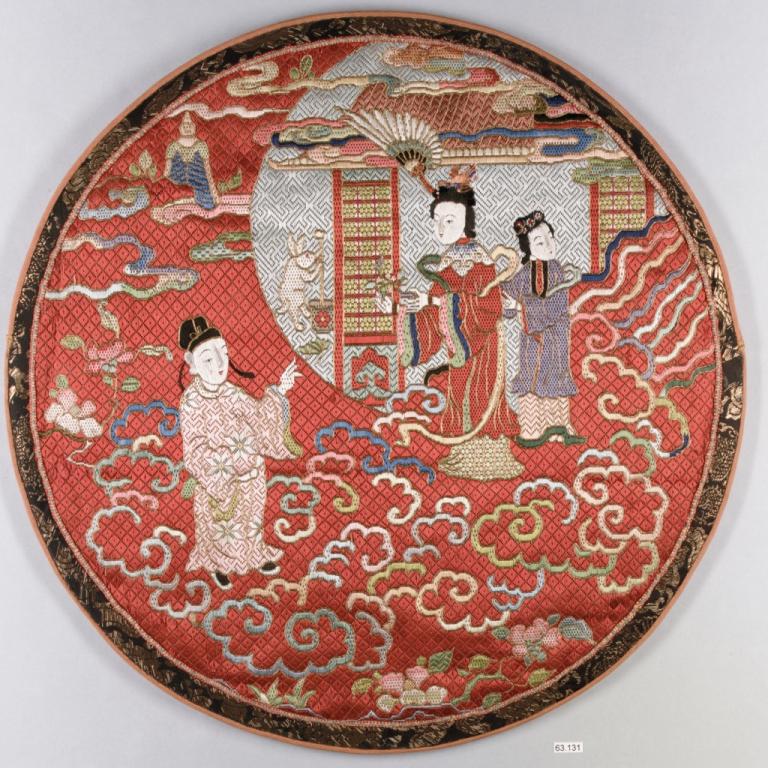
The Tang and Song Dynasties not only saw the birth of maiden’s chamber embroidery, a representative variety of ancient Chinese needlework but also the emergence of embroidered painting combining painting and embroidery with drafts contributed by painters and embroidery work by artisans. This period also saw developments and innovations of embroidery stitching methods, for instances, in how to splitting threads into thinner strands when handling color threads, so as to produce more delicate and vivid lines; the adoption of new stitching methods such as crewel embroidery, couching stitch,gold -thread- outlining, elaborate embroidery, chain-stitch- embroidery and split stitch embroidery; and the practice of supplementary painting and finishing to produce richer expressions. Embroidery with a pattern of pavilion and crane of the Song Dynasty, 25.4cm in length, kept in the Liaoning Provincial Museum. The embroidery is made on a fan-shaped silk fabric with colorful and gold threads. The embroidery draft is a small ruler painting. A collection of Masterpieces of the Song and Yuan Dynasties: Fishing in Reclusion on a Flowering River. eight pieces, Gu Embroidery made by Han Ximeng in 1634, 33.4×24.5cm, kept in the Palace Museum in Beijing. This collection features white plain silk as background embroidered with colorful flowers using velvet threads. Embroidery techniques in Ming Dynasty have distinct geographical features, as represented by Gu Embroidery of Shanghai. Gu Embroidery, based on Song embroidery but with variations, features extremely thin threads, a combination of embroidery and painting with drafts mostly drawn from famous paintings and vivid images; it’s casual in material selection, which gives it unique new features, as a wide range of materials, such as real grass threads, tail feathers of Siam gamecock, thin gold and hair, can be used. Han Ximeng wife of Gu Shouqian from the Gu family, was good at flower painting and embroidery, and enjoyed a reputation among literati. As Gu Embroidery was popular far and wide, the later generations were good at embroidered painting, and many embroidery masters were also masters of embroidered painting. Many embroidery houses in the southern reaches of Yangtze River in Qing Dynasty were often affiliated to the brand of “Gu Embroidery. During late Ming and early Qing Dynasties, government-monopolized- handicraft industry gradually waned, and specialized workshops engaging in commercial production emerged in both urban and rural areas across China, which boosted the development of private handicraft sector; coupled with influences of the practice of combining embroidery with painting by literati and artisans since Tang and Song Dynasties, embroidery techniques and production flourished as never before.
The Treatise on Embroidery (1821) by Ding Pei in Qing Dynasty was China’s first treatise dedicated to embroidery, describes the seven elements, i.e. “neatness, smoothness, straightness, balance, thinness, fluidity and compactness, “of embroidery techniques in plain language. Embroidery products during this period were sold, through trading ports, to Japan, the South Seas, Europe and North America. Sleeve edge with patterns of the twelve Chinese zodiac signs, Su embroidery of the Qing Dynasty, 53x12cm kept in Suzhou Embroidery Research Institute. It’s trim for sewing the cuff by women that features the twelve Chinese zodiac signs with concise composition and elegant color match, bringing out a strong decorative and local flavor. Since late Qing Dynasty, embroidery systems with distinct local characteristics took shape with the rise of “Four Schools of Chinese Embroidery, “which included Su Embroidery of Jiangsu Province, Yue Embroidery of Guangdong Province, Shu Embroidery of Sichuan Province and Xiang Embroidery of Hunan Province. Besides, there were other embroideries, such as Jing Embroidery of Beijing, Lu Embroidery of Shandong Province, Bian Embroidery of Henan Province, Ou Embroidery of Zhejiang Province and those of ethnic minorities. Suzhou Embroidery (suxiu) is mainly produced in Suzhou and Wuxian in Suzhou Province and enjoys a long history.
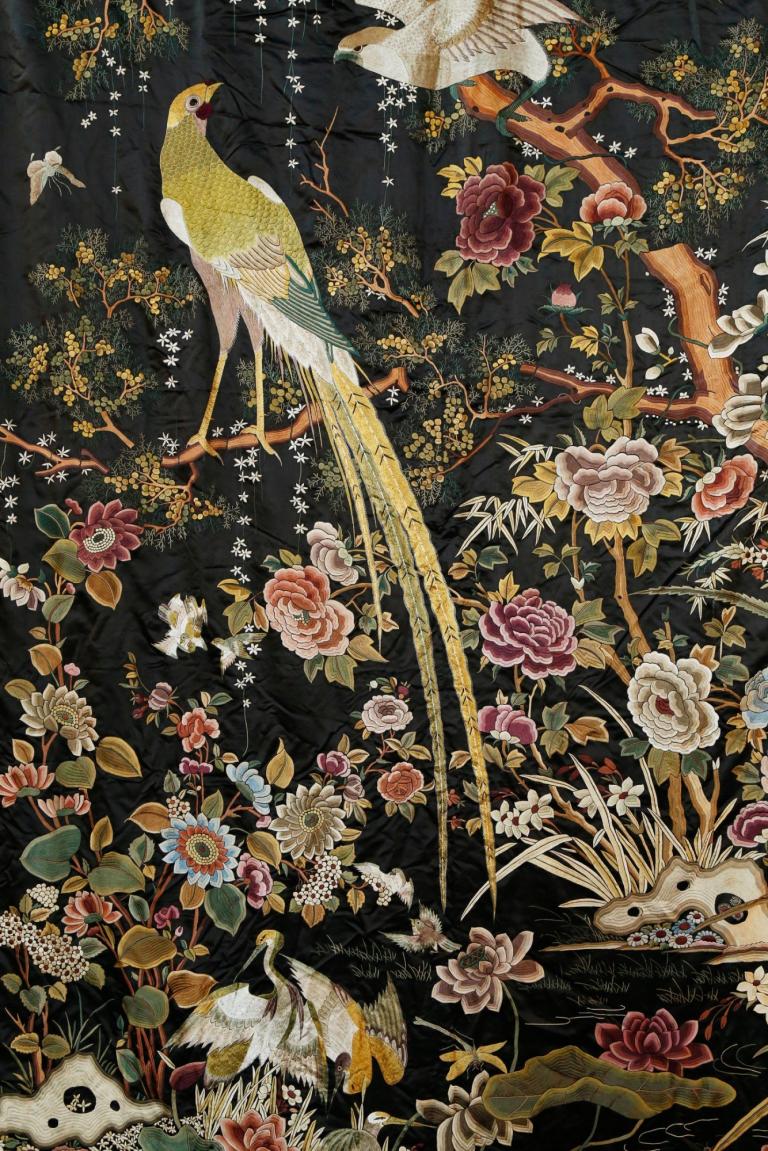
During the Spring and Autumn Period, people from the Wu State applied embroidery to clothes and thus began the origin of Suzhou-style Embroidery. Suzhou Embroidery was famous for its fine needlework and exquisite colors during the Song Dynasty. In the Ming dynasty, it enjoyed full development as almost every household bred silkworms and engaged in embroidery. Wu School Painting also gave impetus to its elegant artistic style and sophisticated workmanship. Suzhou Embroidery reached its peak later in the Qing Dynasty. Drawing on the quintessence of the Gu-style Embroidery of Shanghai and with further development, Suzhou Embroidery gradually renowned for its exquisite, elegant, clear and beautiful artistic style. Wherein, Suzhou gained the reputation of the “City of embroidery.” Suzhou Embroidery is characterize by dedicate needlework with various stitching skills, especially covering stitching skill, which carefully hides the stitches. Three or four similar or alike light and elegant colors are often used together to create a smudging effect. Suzhou Embroidery is widely used in crowns, vests, rank patches official’s uniforms, quilts, pillowcases, shoes handkerchiefs, fan covers, pendants, pouches, draperies, chair covers and drama costume, etc. It falls into two categories: lifelike reproduction of paintings and realistic embroidery featuring beautiful landscape, magnificent pavilions, lively figures, and vivid birds and flowers Fan cover with a pattern of a peacock spreading its tail, Yue embroidery of the Qing Dynasty, 32cm in height, kept in the Palace Museum in Beijing. This piece is embroidered on white plain satin using colorful silk threads. Shen Shou, a master of Suzhou Embroidery of the late Qing dynasty, created “simulation embroidery,” by integrating western painting colors and light shadows into Chinese traditional embroidery techniques and attaching importance to three dimensions of an object. The “Emperor of Italy” and “The Portrait of Queen Elena” created by Shen Shou imitating photos were rewarded the Excellent Award of the Great Exposition in 1915. Later at the 1915 Panama Pacific International Exposition held in San Francisco, U.S., Shen Shou’s another masterpiece, “The Portrait of Jesus,” won the first prize. Shen Shou set up various embroidery associations in numerous places like Beijing, Tianjin, and Jiangsu to foster embroiderers and teach Xue Huan Xiu Pu, the first guidebook of embroidery techniques in Chinese history. In the 1930s, Yang Shouyu created”random stitch embroidery,”which combines crossed short and long stitches with several layers, greatly enriching the artistic significance of Suzhou Embroidery.
Suzhou Embroidery has the biggest population of embroiderers in Chinese modern schools of embroidery with the largest output. After the foundation of a new China in 1949, the Suzhou Embroidery Research Institute was set up which has opened numerous training classes and yielded many masters. As a result, Suzhou Embroidery has boomed with 40 varieties, such as random stitch embroidery, hair embroidery double-faced embroidery, double-faced embroidery in varied colors, miniature embroidery and colorful brocade embroidery. Subjects are diversified with cats, fish, and figures the most famous. Artists like Xu Shaoqing and Li E’ying have been honored as “Master of Chinese Crafts and Arts.” Picture of Five Dragons, a screen with the style of Chao Embroidery, Panjindian needlework on a silk completed by the Chao Embroidery Factory of Guangdong Chaozhou Famory Group Company in 1990s, designed by Chen Liebo Picture of Lotuses and Carps, Shu Embroidery in Sichuan, designed by Guo Ruyu and made by Hao Shuping and Peng Yongxing in 1986. Guangdong Embroidery (yuexiu) is mainly crafted in Guangdong Province. It is well known for its diversified stitches, well-conceived designs, gorgeous colors, and distinct contrasts. Main products include garments, hanging scrolls, long-and-rectangular -shaped pouches, central panels of screens moon-shaped fans, and fan covers, etc. Legend has it that Guangdong Embroidery originated from the Li nationality. Embroiderers used to be males from Guangzhou and Chaozhou. During the Ming Dynasty, Guangdong Embroidery was exported to Europe, favored by many royal members and nobles. Representative works like “To Celebrate Guo Ziyi’s Birthday”and “Su Wu Tending Sheep, “etc. created by 24 embroidery artists including Lin Xinquan, Wang Bingnan, and Li Hebin, received several prizes at the 1910 Nanyang Industrial Exposition held in Nanjing. Since 1950s, numerous masterpieces have been created, like “A Hundred Birds Paying Homage to the Phoenix, “Red Phoenix in Morning Sun,” “Baskets, “I Love Chicks, Parrots, and “In the Morning Light. Portrait of the Jesus, Su embroidery, hand embroidery completed by Shen Shou in 1914. Guangzhou-style Embroidery and Chaozhou-sty Embroidery are the two major schools of Guangdong Embroidery. Guangzhou Embroidery is characterized by elaborate patterns, bright colors and vivid characters with main themes like”A Hundred Birds Paying Homage to the Phoenix”and marine animals like fishes and shrimps.
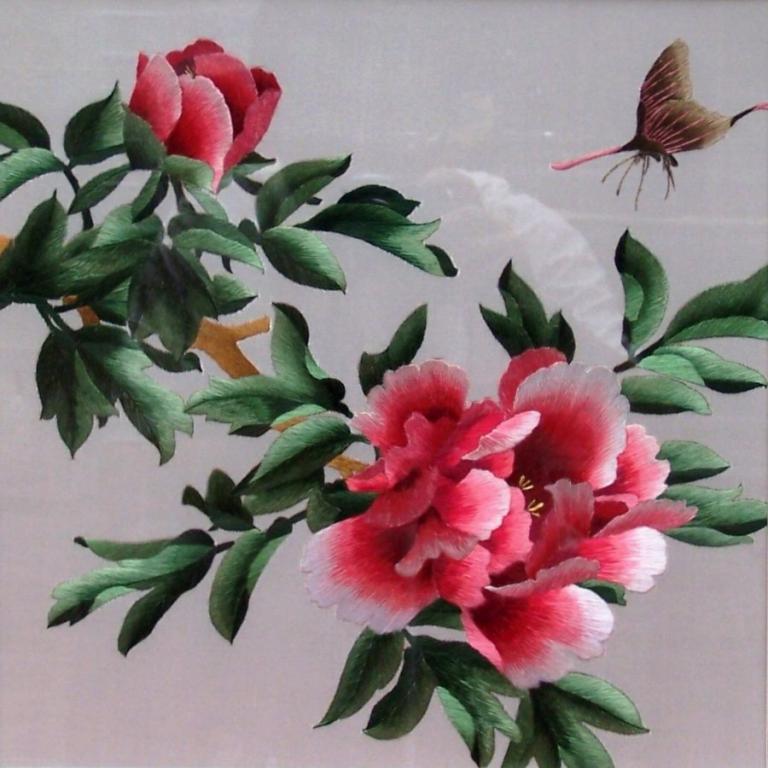
On the other hand, Chaozhou Embroidery is mainly padding embroidery with a favor of gold threads, leaving people bas-relief effect. It applies six embroidery techniques: embroidering, nailing, padding, appliquing, splicing and stitching. Since the mid-Qing dynasty period, Guangdong Embroidery was divided into four categories; woolen embroidery, thread embroidery, cannetille embroidery and gold woolen embroidery. Among them, cannetille embroidery enjoys the highest reputation. It uses gold satin or cannetille as base and lines with gold woolen embroidery, delivering a splendid and magnificent effect. Thus, it is often used in stage costumes, stages and temple furnishing, to create a warm and lively atmosphere. Sichuan Embroidery(shuxiu) steams from areas around Chengdu, Sichuan Province. Using soft satin and colored silk threads as raw materials, Sichuan Embroidery stresses four factors, including neat stitches, bright threads, close soft texture, and stitching techniques of”he”and”ning.””Che”refers to the technique of stitching from the center to the periphery while”Ning”refers to adding or reducing long and short stitches from the periphery to the center. Apart from embroidered screens for appreciation purpose, Sichuan Embroidery is mainly used in articles of everyday use like quilts, pillowcases, garments, shoes, headpieces, tablecloth and handkerchiefs. Major subjects include flowers, birds, insects, fishes, landscape, figures, auspicious lines, and traditional ornamentation, rendering a sense of lucky and distinctive folklore.① Lion, Xiang Embroidery in Hunan, single-side embroidery with silk threads designed by Yang Yingxiu and made by Liu Aiyun in 1980 ② Ladies with Head-pinned Flowers, Bian embroidery in Henan Province, 180cm in height, kept in the Cultural Embroidery Institute in Kaifeng Henan Province in the 1990s. Bian embroidery is basically characterized by “flat, neat, elaborate, vivid, bright, clean and smooth.”③Venice tablecloth, designed by Zhao Xuexiang and made by Zhejiang Xiaoshan Lace Factory through hand knot and embroidery with cotton threads and linen in 1962 Sichuan Embroidery has a long history. Chang Qu in the Jin Dynasty listed Sichuan Embroidery and Sichuan Brocade as the local specialties in his “The Chronicles of Huayang. In the late Qing Dynasty, Sichuan Embroidery borrowed the merits of Gu -style Embroidery and Suzhou Embroidery based on the local traditional embroidery techniques, and became one of the most important national embroidered goods. Today, there are both giant embroidered screens and pocket-sized embroideries, as well as famous ones for appreciation and daily use.”Hibiscus&carp”–a giant pedestal-styled screen in the Sichuan Hall of the Great Hall of People in Beijing, “Maids Playing Music in Shu Palace”-a famous Sichuan Embroidery hanging screen, “Water Grasses and Carp”-a pedestal-styled screen with double-faced embroidery in varied colors and”Giant Pandas”are all contempora masterpieces.
Xiang Embroidery is a general name for the embroideries in areas around Changsha, Hunan Province. The embroideries unearthed from Chu tombs in Changsha in 1958 suggest that local embroidery in Hunan had already experienced certain development as early as the Spring and Autumn Period and had reached a high level in the Western Han Dynasty as evidenced by the 40 pieces of clothing unearthed from Mawangdui tombs of Western Han Dynasty in Changsha in 1972. In Qing Dynasty, embroidery became popular all over the urban and rural areas of Changsha and the majority of peasant women took embroidery as profession. In the late Qing Dynasty, Xiang Embroidery formed its own style. During the reign of Guangxu(1875-1908),Hu Lianxian, an artisan of embroidery, opened the “Wu Caixia Embroidery Store”in Changsha the products of which were excellent and spread everywhere, enabling Xiang Embroidery to become famous nationwide. Xiang Embroidery, which uses pure silk, hard satin, soft satin, transparent chiffon as well as silk thread and floss of a variety of colors as the main materials, skillfully integrates embroidery with China’s traditional painting, poetry, calligraphy and inscriptions. Based on traditional Chinese paintings, Xiang Embroidery is particularly famous for its animal subjects including lion and tiger. The embroidery is vivid and colorful and is of strong texture and bold style, enjoying a good reputation of “a flower seems to send off fragrance, bird seems to sing, a tiger seems to run and a person seems to breathe.
Happiness and Longevity, a mirror cover with the style of Jing embroidery, 40cm in diameter, made in the 1920s, kept in the Academy of Arts& Design Tsinghua University. piece embroidered with silk and velvet threads on silk fabric, it has an elaborate coloring and full and dense images that fit together perfectly. Traditional Xiang Embroidery is featured by the skillful use of threads. Firstly, the silk thread is soaked in water containing pod nuts and when the water is evaporated, the thread is wiped with bamboo paper, thus making it easy to embroider as the silk is bright, clean, smooth and lint-free. Secondly the thread is dyed with gradient colors and is used for stitching, and natural sfumato effect will be achieved after embroidery. Thirdly, the silk is as thin as a hair and surpasses the “hair embroidery” in Gu Embroidery. The exquisite embroideries made with the silk are commonly known as “wool fine embroidery” locally. The stitch pattern of Xiang Embroidery is very expressive. On the basis of the Tao stitching Chan stitching (commonly known as “disorderly stitching”) is mainly adopted in Xiang Embroidery, making the image embroidered seem real and vivid. Based on traditional double-sided embroidery, the modern Xiang Embroidery has created double-sided disparate embroidery, both sides of which have the same profile but disparate images, colors and stitch patterns. The embroideries mainly include such daily necessities as quilt covers and pillowcases as well as high-end screens. The embroidered pictures of still lives combine the modern Xiang Embroidery with the modern indoor ornaments and modern art. Since 1949, machine embroidery has developed rapidly due to higher efficiency, less manpower, better quality and lower price. It has broad range of stitch patterns including Dazi embroidery, Changzhen embroidery and Baogeng embroidery. Such new handicrafts as woolen embroidery, multi-transplantation- photography and painting have been developed in Shanghai, Tianjin, Yantai and other places.
Furthermore, most national minorities are good at embroidery, such as the Miao, Yi, Li, Tujia and Uyghur nationalities which all possess developed embroidery crafts with national features. Embroideries are not only decorations for wears and daily necessities, but also a way to manifest the gifts and skills of the minority women. In addition, cross-stitch work, applique(sewing fabric shapes onto cloth) and drawnwork are also included in a major embroidery type called “Tiaobu embroidery. Drawnwork is broad variety including lacework, tuscany lace, cutwork, drawnwork and buttonhole. Introduced from foreign countries in the late Qing Dynasty, the crafts are divided into such two types as silk drawing on the cloth and thread knitting to form decorative pattern, which offer plenty of variation and are suitable for modern home decoration.
